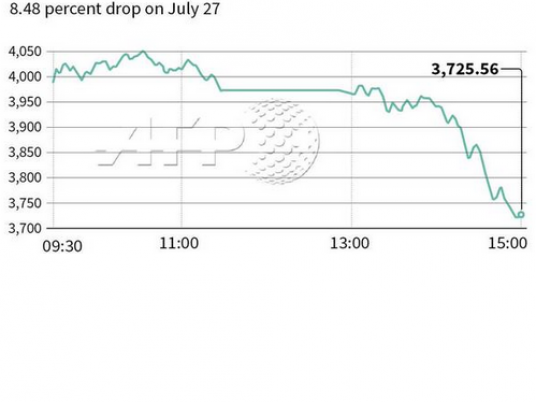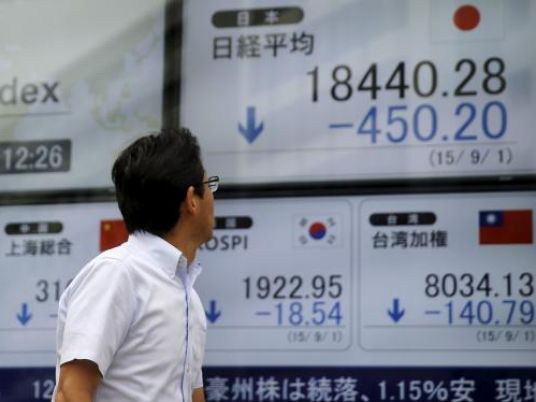
Global financial markets looked set for another rough week on Monday, with stocks and commodities falling ahead of data that could give clues on when the U.S. will raise interest rates and surveys which are likely to point to further weakness in China.
Confusion over policy direction in the world's two largest economies sent global markets into turmoil early last week, with the wildest price swings in years pushing investors to the exits.
European shares looked set to follow Asian shares and U.S. stock futures lower on Monday, with Germany's share index .GDAXI expected to open down 1.35 percent and France's CAC 40 .FCHI likely to fall 1.39 percent, according to IG. The UK market is closed for a public holiday.
U.S. stock futures ESc1 slid 1 percent, suggesting weakness on Wall Street later in the session.
"This is a market that is walking on glass; China seems to be the central theme feeding into a lot of these things but today the focus is very much on U.S. interest rates again," said, James McGlew, executive director of corporate stock broking at Argonaut in Australia.
MSCI's broadest index of Asia-Pacific shares outside Japan .MIAPJ0000PUS shed more than 1 percent and is set to fall 10 percent this month, its worst monthly drop since May 2012.
Selling intensified as China markets extended losses. Shanghai stocks .SSEC, the epicentre of this month's whip-saw action, were down more than 3 percent at one point. They have plunged more than 40 percent since mid-June.
Japan's Nikkei .N225 and Australia were down 2 percent before paring losses.
"A pull back in the market was to be expected as some investors are taking profits after the two-day rally," wrote Gerry Alfonso, director of Shenwan Hongyuan Securities, referring to a brief rebound late last week.
"Investors seem to be waiting until the manufacturing PMI figure is released later this week before making significant decisions."
A Reuters poll showed China's official factory sector activity likely fell to a 3-year low in August. Other surveys on Chinese factory and service sector activity will also be released on Tuesday.
Traders are also on edge ahead of U.S. business surveys, factory orders, trade data and Friday's nonfarm payrolls this week, after comments by a top Federal Reserve official suggested that a September rate rise was more likely than some investors expected.
Fed Vice Chairman Stanley Fischer, speaking at the central bank' conference in Wyoming, said recent volatility in global markets could ease and possibly pave the way for a rate hike.
Prospects of higher interest rates and returns in the United States combined with China's slowdown have diminished the appeal of emerging markets as investors have dumped riskier assets.
Investors sold $5.9 billion of emerging market assets between Aug. 20-26, a sharp increase from $1.5 billion the week earlier, according to Nomura fund flows data.
Credit markets, often a harbinger of things to come for equities, spelt further pain in store for emerging markets.
An index for Asian high-yield credit has fallen sharply this month compared to a relatively steady performance in the investment grade index, according to Thomson Reuters data.
The dollar eased 0.6 percent to 121.03 yen JPY= after rising to the week's high of 121.76 on Friday following the Fed officials' comments that kept prospects of a September hike alive.
The euro was up 0.6 percent at $1.12550 EUR= after touching an eight-day low of $1.1156 on Friday.
The market will watch the European Central Bank's policy meeting on Thursday to see if it will be inclined to ease monetary policy further in the wake of the recent global market mayhem, though no imminent change is expected.
U.S. crude oil prices dipped as their biggest two-day surge in quarter of a century ran its course.
U.S. crude CLc1 was down 1.3 percent at $44.62 a barrel after jumping more than 6 percent on Friday on frenetic short-covering fuelled by violence in Yemen, a storm in the Gulf of Mexico and refinery outages. [O/R]
The contract was still down nearly 5 percent on the month, when it hit a 6-1/2-year low last week in the wake of China-led global growth fears.
Gold struggled to recover from last week's losses, even in the face of a softer dollar. Spot gold XAU= was flat at $1,133.98 an ounce, after dropping more than 2 percent last week in its steepest decline in five weeks. For the month, the metal was up 3.5 percent.
(Additional reporting by Shinichi Saoshiro in TOKYO, Samuel Shen and Pete Sweeney in SHANGHAI and Pauline Askin and Charlotte Greenfield in SYDNEY)



